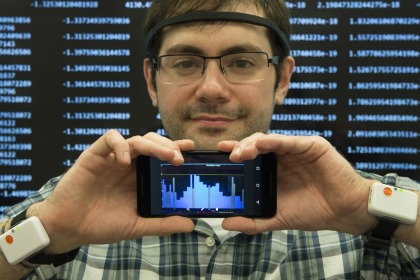When IBM’s inventors heard about Eric Clark’s data-driven healthcare projects at the University of Vermont, they asked him to join their efforts to develop personal technology that will help doctors take care of patients.

Eric Clark, M.S., UVM doctoral candidate. (Photo: Courtesy of IBM)
When IBM’s inventors heard about Eric Clark’s data-driven healthcare projects at the University of Vermont, they asked him to join their efforts to develop personal technology that will help doctors take care of patients.
That precise point – where personal technology and personalized medicine intersect – is where Clark, a doctoral candidate in mathematics and engineering, is focusing his efforts for the UVM College of Medicine, says his mentor, Christopher Jones, Ph.D., assistant professor of surgery and director of global health economics in the Center for Clinical and Translational Science.
“This really is the final frontier, separating signals from noise,” Jones says. “We have tackled everything else.”
It’s no wonder that IBM would take an interest in Clark; his expertise is big-data crunching as it relates to emotional responses and personal health decisions.
“It’s really important to connect patients and doctors for more personalized healthcare,” he says.
For its latest project, IBM is collaborating with pharmaceutical company Pfizer to build a monitoring system using basic sensors and mobile devices that will remotely connect Parkinson’s disease patients with physicians and researchers. In what the company calls a “blue sky” approach, it’ll use its data-processing power to provide real-time symptom information to help clinicians better understand the patient’s disease progression and medication response – ultimately assisting with clinical trials and speeding the process for improved treatments.
Clark started a short-term stint as a data research scientist at IBM’s Watson Research Center in Yorktown Heights, N.Y., in March 2016. He is working with sensors and wearables and their applications to health while he helps the companies figure out how to boil down all the information those devices will generate into a “scalable” use.
“That whole process, it’s a two-way street,” Clark says. “It’s a learning experience for us, too.”
He envisions interviewing doctors and building the technology around the records and diagnostics they want to use. If they had all the data on a patient they could imagine, what details would they want to see? What would be most useful? They could use this for post-surgical applications, checking in on a patient’s recovery and pain management. Customization is key, Clark says.
The IBM project is a large signal-processing experiment. Clark will create mathematical algorithms to collect the data, interpret it, visualize it and apply it to a goal, like understanding patient needs and emotions outside of the hospital.
Off-the-shelf sensor technology can record physiological changes such as heart rate, breathing and perspiration. Sensors are everywhere: in clothes, on shoes, in cars and on our wrists.
“Really, the applications are endless…[the Internet of Things or IoT] is the space that the world needs to be in,” Clark says.
In the UVM Department of Surgery, Clark had started pulling data from wearables and mobile technology, such as exercise watchbands and sensor-infused clothing. “We were doing simple stuff over here,” Jones says.
IBM gains UVM’s innovative approach in this arena, while UVM gains the company’s corporate heft, Jones says. “What they do have is computer power, financial resources and a willingness to see these projects through,” he explains.
A data-driven incentive program on which Jones and Clark are collaborating - called trUStr - that is a State of Vermont-funded spin-off of UVM, also caught IBM’s attention, Jones says. TrUStr harnesses technology to analyze people’s behavioral changes and decisions related to their health, such as talking regularly to their provider, walking more or being adherent with their medication, and come up with more effective ways to reward them. .
“TrUStr embodies a new breed of university startups capitalizing on the interface between the Internet of Things and human behavior,” says Corine Farewell, D.V.M., M.B.A., director of the UVM Office of Technology Commercialization. “We are very optimistic about this opportunity.”
Clark was recently featured in a Fortune magazine article about the IBM project.